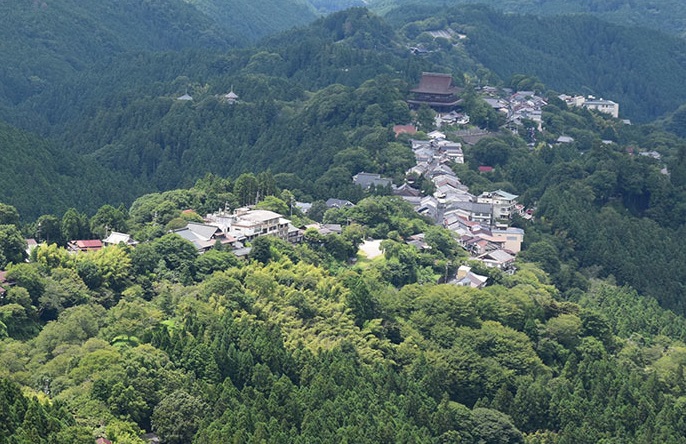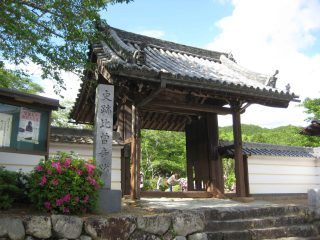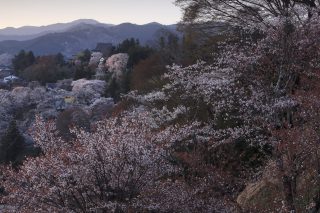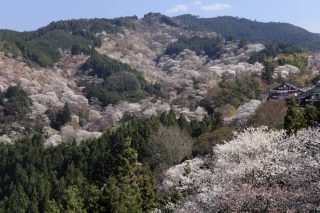Today Mt. Yoshino is renowned as Japan’s premier spot for cherry blossom viewing in the spring. That reputation stems from Yoshino’s long history as a religious center, as well as its association with notable historical figures such as Minamoto no Yoshitsune (1159–1189) and Emperor Go-Daigo (1288–1339).
Archaeological evidence suggests that people have lived in the Yoshino area since at least 14,000 BCE. Yoshino Mikumari Jinja Shrine may have been founded during the Yamato period (ca.300–710), when the first Japanese imperial court was established in the nearby Nara Basin. Water was essential for the rice agriculture of the period, and since Yoshino was a crucial source of water for crops, the shrine may have initially honored a water goddess.
At the end of the seventh century CE, the legendary ascetic En no Gyoja (634–ca. 700) erected a religious sanctuary on Mt. Omine, south of Yoshino, devoted to a blend of folk beliefs, as well as to Shinto, Buddhism, and Esoteric Buddhism. The faith drew other adherents and become known as Shugendo. En no Gyoja later founded Kinpusenji Temple in Yoshino, which became a center for Shugendo practice. Around this time, poets were praising Yoshino for its natural beauty; their poems about the mountain are preserved in the Man’yoshu, Japan’s oldest extant collection of verse. The poet Saigyo (1118–1190) continued this tradition in the Heian period (794–1185), when he lived for three years in a hermitage in the Oku-senbon area of Yoshino.
This remote area also served as a refuge for Yoshitsune, perhaps Japan’s most famous samurai. After Yoshitsune helped lead the Minamoto clan forces to victory in the Genpei War (1180–1185) against the Taira clan, his stature incurred the jealousy and wrath of his brother, Minamoto no Yoritomo (1147–1199), forcing him to flee from Kyoto to Yoshino. He took sanctuary in Yoshimizuin Temple (now Yoshimizu Jinja Shrine) and Oku-senbon. He was later forced to flee the area disguised as an ascetic, leaving behind his mistress Lady Shizuka (1165–1211). This became one of the most written-about episodes of Japanese literature, retold in poetry, Noh, and Kabuki plays, as well as in modern-day manga, novels, and TV dramas.
In the mid-fourteenth century, Emperor Go-Daigo managed to overthrow the Kamakura shogunate (1185–1333) established by Yoritomo. The emperor was only able to maintain power for three years before the warlord-led forces reasserted control, forcing him to flee to Yoshino, where he established his court at Yoshimizuin Temple. The clash between the emperor’s forces based in this Southern Court and the shogun-controlled Northern Court in the capital lasted over 50 years and is known as the Nanboku-cho period (1336–1392); Go-Daigo’s successors ultimately yielded to the domination of the warlord-led Ashikaga shogunate (1336–1573). In 1594, the warlord and national unifier Toyotomi Hideyoshi (1537–1598) hosted a cherry blossom viewing (hanami) party at Yoshino for about 5,000 people, ensuring its popularity as Japan’s premier spot for drinking under the petals.
The imperial house reasserted its supremacy after the Meiji Restoration of 1868, and Emperor Meiji (1852–1912) declared Go-Daigo and his descendants the legitimate emperors in the Nanboku-cho period. He ordered the construction of Yoshino Jingu Shrine to honor Go-Daigo, who was then deified.
In the 1870s, the Meiji government, in a bid to establish Shinto as Japan’s official religion, outlawed Shugendo, and its temples were destroyed or converted for other uses; for example, Yoshimizuin Temple was transformed into Yoshimizu Jinja Shrine. After World War II, laws guaranteeing religious freedom brought about the reestablishment of Shugendo, and it began attracting practitioners once again. In 2004, Yoshino became one of the UNESCO World Heritage sites as part of the Sacred Sites and Pilgrimage Routes of the Kii Mountain Range.




